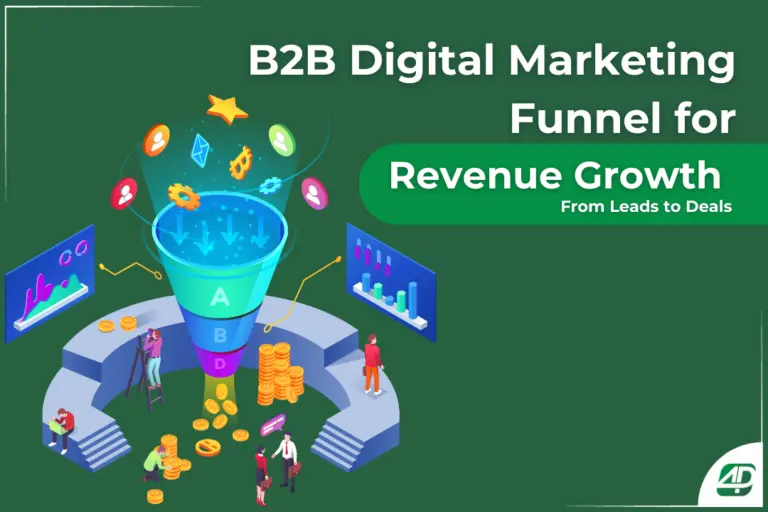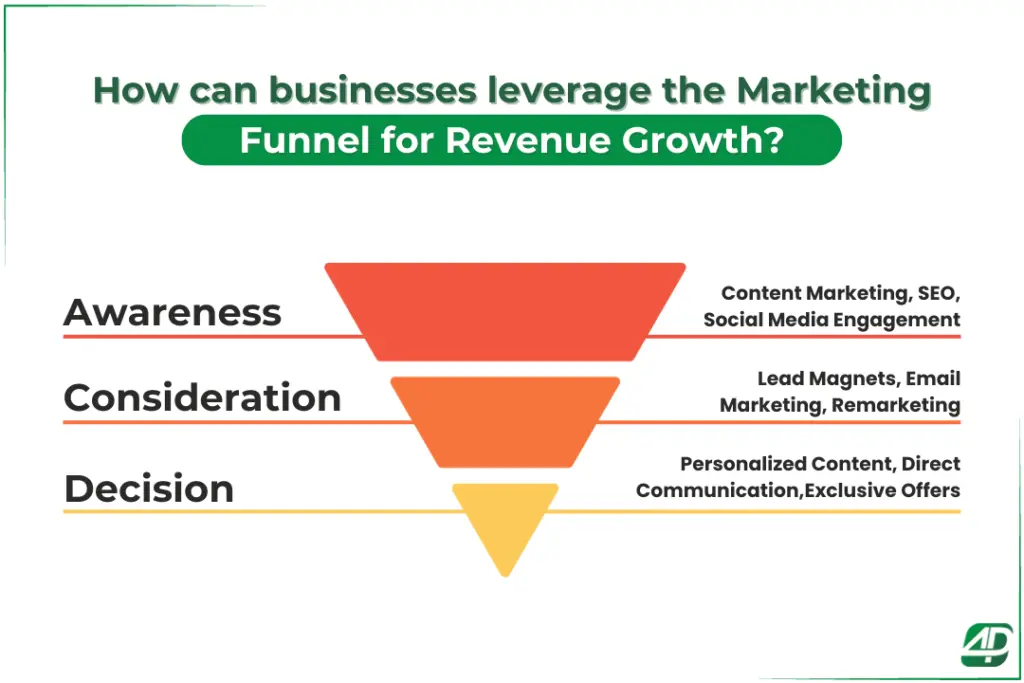From Leads to Deals: Optimizing Your B2B Digital Marketing Funnel for Revenue Growth

Introduction
The process of turning leads into deals in the fast-paced world of B2B digital marketing requires a calculated dance of awareness, engagement, and conversion.
In this blog, we unravel the intricacies of optimizing your B2B digital marketing funnel for sustainable revenue growth.
Let’s delve into actionable insights and proven tactics to transform your leads into lucrative business deals.
Highlights:
What is a B2B Marketing Funnel?
Picture your B2B marketing process as a funnel – a pathway guiding potential clients from initial awareness to a meaningful business relationship.
The B2B marketing funnel comprises stages, each representing a specific interaction level with your brand. These stages include awareness, consideration, and decision – all leading towards the ultimate goal of converting leads into deals.
Why Does Your B2B Business Need a Marketing Funnel?
A marketing funnel is a pathway for nurturing leads & guiding them through a purposeful journey. It gives you insight into consumer interactions, enabling you to adjust your tactics accordingly.
You may maximize resource allocation and raise the probability of converting leads into successful deals by coordinating your efforts with the funnel.
How can you leverage the marketing funnel for retargeting –
- Businesses can craft tailored retargeting campaigns with customized CTAs aligned to the next logical step by segmenting the audience based on funnel interactions.
- Managing ad frequency, ensuring cross-channel consistency, and tracking funnel progression through analytics allow for continuous optimization.
- Experimenting with retargeting sequences further enhances user engagement, providing a cohesive and personalized journey that increases the likelihood of conversion.
Sales Funnel vs. Marketing Funnel
While often used interchangeably, sales and marketing funnels are distinct yet interconnected. The marketing funnel focuses on lead generation and nurturing, building awareness and interest.
On the other hand, the sales funnel takes over when leads are sufficiently warmed up, guiding them toward the final transaction. A seamless transition between the two ensures a cohesive and practical approach.
Let’s understand how a marketing funnel can be leveraged for revenue growth.
How can businesses leverage the Marketing Funnel for Revenue Growth?
The marketing funnel is a crucial framework companies can use to guide potential customers through various stages of the buyer’s journey, ultimately leading to revenue growth.
Here are the steps and processes businesses can follow to leverage the marketing funnel for revenue growth:

1. Understand Your Audience :
- To kickstart your revenue engine, you must attract the right traffic. Understand your target audience’s needs, preferences, pain points, and behaviour.
- Develop buyer personas to create a detailed representation of your ideal customers.
2. Top of the Funnel – Awareness Stage :
-
Content Marketing:
- Create valuable and educational content to generate awareness. This could include blog posts, social media content, and videos. SEO (Search Engine Optimization):
- Optimize your content for search engines to increase visibility and attract organic traffic. Social Media Engagement:
- Engage with your audience on social media platforms to build brand awareness. This will keep your audience hooked on your brand.
3. Middle of the Funnel – Consideration Stage :
-
Lead Magnets:
- Offer valuable resources such as whitepapers, eBooks, or webinars in exchange for contact information to generate leads. Email Marketing:
- Nurture leads through targeted email campaigns, providing more in-depth content and addressing specific pain points. Remarketing:
- Use targeted ads to stay in front of leads who have already engaged with your brand. Rather than closing one deal, focus on building a lasting connection.
4. Bottom of the Funnel – Decision Stage :
-
Personalized Content:
- Tailor your content to address the specific needs and concerns of leads in the decision-making stage. Direct Communication:
- Initiate one-on-one communication through consultations, product demonstrations, or free trials. Exclusive Offers:
- Provide incentives, discounts, or exclusive offers to encourage the final conversion.
B2B buyers have evolved in this digital age. They no longer convert with just a fast sales pitch. You have to use specific tactics to make this marketing funnel the backbone of your business.
6 ways to make the marketing funnel the backbone of your business:
1. Analyze and Optimize :
- Regularly analyze key performance indicators (KPIs) at each funnel stage, including conversion rates, click-through rates, and customer acquisition costs.
- Identify areas of improvement and adjust your strategies based on data-driven insights.
2. Customer Retention :
- Nurture your client relationships even after you close the deal. Happy clients repeat business and become advocates, driving more traffic.
- Focus on post-purchase engagement to ensure customer satisfaction and loyalty.
- Implement customer loyalty programs, gather feedback, and provide ongoing value through additional content and offers.
3. Implement CRM (Customer Relationship Management) :
- Use CRM tools to manage and track customer interactions throughout the funnel.
- Maintain a database of customer information to personalize future interactions. Refine and Scale:
- As businesses navigate a sea of options, a well-optimized website becomes a beacon, guiding potential clients and partners to your virtual doorstep.
4. Refine and Scale :
- Continuously refine your funnel based on customer feedback and changing market dynamics.
- Once you have a successful funnel in place, consider scaling your efforts by expanding your reach or introducing new products and services.
5. Measure ROI :
- Calculate the return on investment (ROI) for your marketing efforts.
- Assess the revenue generated against the costs incurred.Use this information to make informed decisions about resource allocation and future marketing strategies.
6. Seek Professional Assistance :
- Consider partnering with experienced B2B digital marketing agencies like the 4P Solutions for expert guidance and tailored strategies.
By diligently following these steps, businesses can effectively use the marketing funnel to attract, nurture, and convert leads into customers, driving sustainable revenue growth over time.
Here are some Tips for Creating Lead Magnets and Nurturing Leads:
-
Identify Pain Points:
- When crafting lead magnets, dive into your audience’s real pain points, offering solutions that genuinely matter to them. Provide Value:
- Make sure your lead magnets aren’t just downloadable assets but valuable resources that your audience can immediately benefit from. Segment Your Audience:
- Segment your audience like you’re tailoring a gift – the more personalizd, the better the engagement. Use Compelling CTAs:
- Craft CTAs that feel like a friendly nudge, guiding users to take the next step with your lead magnets willingly. Multi-Channel Distribution:
- Shout about your lead magnets from the digital rooftops – use every channel available to reach your audience. Automate Follow-Up:
- Set up automated email sequences that feel less like robotic follow-ups and more like a helpful companion on their journey. Monitor Engagement:
- Monitor engagement metrics, like a conversation between friends, to understand how your lead magnets are resonating. Continuous Optimization:
- Your lead magnets need constant updating – keep them fresh, relevant, and aligned with what your audience wants. When crafting lead magnets, dive into your audience’s real pain points, offering solutions that genuinely matter to them.
Conclusion
Optimizing your funnel is the key to sustainable revenue growth.
By understanding the stages of the funnel, targeting the right audience, and employing effective digital marketing tactics at each stage, you pave the way for transforming leads into lucrative business deals.
Remember, it’s not just about acquiring leads but strategically guiding them through a purposeful journey that culminates in lasting and profitable relationships.
How The 4P Solutions can play a role in Driving Your Leads to Deals?
Harnessing more than a decade of specialized experience in B2B digital marketing, The 4P Solutions team stands out in the art of transforming leads into lucrative deals.
- Our experts pinpoint key market opportunities, ensuring your digital platforms attract the right audience by understanding industry nuances and audience trends.
- We customize campaigns to resonate with your specific audience, amplifying your online presence’s effectiveness for tangible financial returns.
- Beyond attracting the right audience, we optimize digital platforms for conversion, guiding leads seamlessly to transform clicks into profitable relationships.
For personalized guidance on optimizing your B2B funnel, schedule a free consultation with our experts today call us at 8928609451.
FAQ’s:
Data analytics and customer feedback provide actionable insights into customer behavior, allowing businesses to identify pain points, optimize funnel stages, and refine strategies. This iterative process fosters continuous improvement, ultimately boosting ROI by aligning the funnel with evolving customer needs.
Marketing automation streamlines repetitive tasks, nurtures leads with personalized content, and enables timely follow-ups, allowing teams to focus on high-value activities and providing a seamless and efficient B2B sales funnel experience.
Build a B2B marketing and sales funnel by aligning marketing and sales teams, leveraging data-driven insights to optimize each funnel stage, implementing lead scoring for prioritization, and consistently analyzing and refining your strategies for maximum return on investment (ROI).
To build an effective B2B sales funnel, start by defining clear buyer personas, create awareness through targeted content, capture leads with lead magnets, nurture them with personalized communication, and guide them through the decision-making stage with tailored content and direct interactions.
